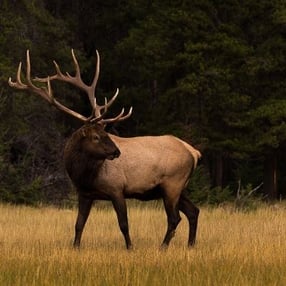
Hiking in Colorado is a year-round experience for many avid outdoor enthusiasts even in the winter when snow provides an extra obstacle for outdoor recreation. However, you may notice areas with trail closures occurring during the winter months no matter if you find yourself on Forest Service, BLM, or state land. There are several different reasons as to why these trails are closed however, the largest reason is to protect wildlife.
If you have spent time in Colorado, you have most likely seen at least one Colorado’s megafauna species like elk, moose, deer and bighorn sheep. You may also have experienced the changing of the seasons marked by the golden aspen leaves that litter the ground and the falling of snow that creates a sparkling winter scene in the forests and on the mountains. These winters may be beautiful but the winter environment creates a very stressful time for local wildlife because of the limited access to habitat and nutritious forage. Ensuring these animals have the proper habitat and resources available to survive alongside humans is essential to their continued presence in our state.
As outdoor recreation continues to increase in Colorado during the winter it is critical to keep in mind local animal species that may be disturbed by human presence. Deer and elk are two species that are specifically sensitive to increased human activity sharing their habitat. Typically, deer and elk eat less and lose weight during the winter months. This is especially true for mule deer who are more selective about their food preferences compared to elk who are generalists. Because of this, mule deer and elk attempt to minimize their energy expenditures as much as possible when the temperatures are cold and snow covers the ground. However, human activity in preferred deer and elk areas can cause these animals to expend unnecessary energy by trying to avoid human encounters. This time away from activities such as feeding and resting which can also affect survival and reproduction rates.
When spring arrives and the snow begins to melt, deer and elk enter another sensitive period: calving. Elk and deer give birth to young in May and June, after the harsh winter months when newborns would not survive. However, minimizing human activity in predominant wildlife areas allows pregnant and nursing females time and space to nurse their young until they are strong enough to move with the herd. In addition, spring is a critical period for migration. Deer and elk are by nature migratory species and primarily migrate from higher to lower elevations in the winter, then move from lower elevations back to higher elevations as the spring brings warmer weather.
Although trail closures occur in popular grazing and browsing areas, wildlife do not restrict themselves to these areas. Therefore, you may encounter animals while recreating anywhere in the outdoors. What should you do if you see a deer or elk? Keep as much distance as possible to ensure safety for both yourself and the animal, just as if you are in the grocery store and are practicing safe social distancing. The next time you plan a trip into the Colorado wilderness make sure to respect these important trail closures and share the message with friends and family to ensure everyone is recreating responsibly to protect our beloved wildlife.

Dominique Rosario is a Naturalist at Walking Mountains Science Center. In her free time she loves finding new places to explore and trying out new restaurants.
Resources:
Elk Movements in Colorado: Being There When The Elk are There. Steve Prentice. Colorado Parks and Wildlife. https://cpw.state.co.us/learn/Pages/EHU-CH2-L05.aspx
The Whitetail’s Secret Weapon: Birth Timing. Deer and Deer Hunting. https://www.deeranddeerhunting.com/deer-scouting/deer-behavior/whitetails-secret-weapon-birth-timing
Winter Range Disturbance. Mule Deer Working Group. https://www.wafwa.org/Documents%20and%20Settings/37/Site%20Documents/Working%20Groups/Mule%20Deer/FactSheets/MDWG%20Fact%20Sheet%2017%20Winter%20Range%20Disturbance.pdf
Seasonal Closure Information. Stay the Trail Colorado. https://staythetrail.org/seasonal-closure-information/
Forest Service changes some seasonal trail closures on Vail Valley trails. Vail Daily. https://www.vaildaily.com/news/forest-service-changes-some-seasonal-trail-closures-on-vail-valley-trails/
Vail Valley trail closures intended to help wildlife: Animals need time to recover from winter starvation, and to peacefully have babies. Vail Daily. https://www.vaildaily.com/news/vail-valley-trail-closures-intended-to-help-wildlife/
Vail Valley Seasonal Trail Closures. Vail Valley Mountain Trails Alliance. https://www.vvmta.org/seasonaltrailclosures/








